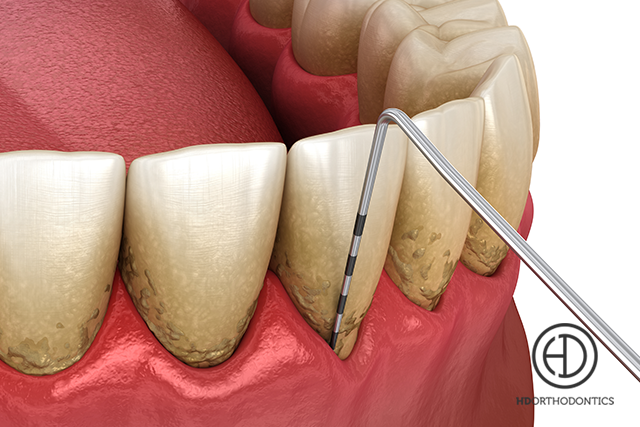Can I Still Get Braces if I Have Gum Disease?


Long Beach, CA – Gum disease is very common, affecting nearly half of all adults over the age of 30. Outward signs of gum disease can include red, swollen, or even bleeding gums. Some patients, however, may have gum disease but not display any symptoms. It is important to have a thorough check-up to ensure your mouth is healthy before receiving any sort of specialty dental treatment such as orthodontics.
Orthodontic treatment can improve the look and function of your smile. But, orthodontic treatment requires healthy mouths to be effective. Gum disease doesn’t rule out the ability to receive orthodontic treatment, but it must be treated and under control before beginning treatment.
This is because serious gum disease, referred to as periodontitis, can lead to the destruction of not only gum tissue, but also the ligaments and bone that are needed to secure your teeth into their places. During orthodontic treatment, braces are used to guide your teeth through the bone. The bone and ligaments then remodel around the tooth to secure it in its new location. If you have experienced loss of bone and ligament due to gum disease, there may not be enough healthy tissue left to hold your teeth in place.
This is one of the many reasons it is important to maintain regular appointments with your general dentist. Gum disease can be easily treated in its early stages, but if it progresses to periodontitis, treatment can be more involved, oftentimes requiring flap surgery or bone and tissue grafting.
If you currently have some form of gum disease or suspect you may, it is important to visit your dentist or a periodontist so the gum disease can be treated as soon as possible. Symptoms of gum disease include:
- Swollen or puffy gums
- Bright red or purple gums
- Tender gums
- Bleeding gums
- Bad breath or bad taste in the mouth
- Pus between teeth and gums
- Loose or shifting teeth
The good news is that for those patients without existing periodontitis, orthodontic treatment may be a solution to preventing future gum disease. In many patients, gum disease is caused by bacterial overgrowth from improper brushing. Crowded and misaligned teeth can be harder to adequately brush, leading to a higher risk of gum disease. Properly aligning the smile is not only more aesthetically pleasing, but it can also lead to better oral health, too.
While orthodontic treatment can improve your oral health and help minimize the risk of future gum disease, receiving treatment while having active gum disease may put your smile at risk. Infected or inflamed gums can compromise your orthodontic result.
Traditional braces are excellent at moving teeth to their desired locations, but make it difficult to properly brush as the brackets and wires create many nooks and crannies where food debris can get caught. Patients with minor, treatable gum disease may benefit from Invisalign treatment. Invisalign aligners are removable, making it easy to properly care for your teeth and gums during your treatment.
Call Dr. Desh today to learn more about orthodontic treatment. She can determine if your smile is healthy enough for treatment and help you start your journey to a healthier smile.

